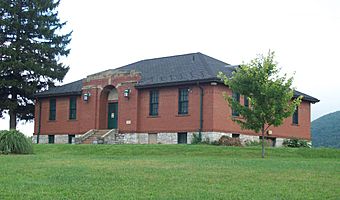Bellefonte Armory facts for kids
Quick facts for kids |
|
|
Bellefonte Armory
|
|

Bellefonte Armory, August 2010
|
|
| Location | E. Bishop St., Bellefonte, Pennsylvania |
|---|---|
| Area | 7.9 acres (3.2 ha) |
| Built | 1930 |
| Built by | Tidlow Brothers |
| Architect | Kuntz, Joseph F. |
| Architectural style | Colonial Revival |
| MPS | Pennsylvania National Guard Armories MPS |
| NRHP reference No. | 89002068 |
| Added to NRHP | December 22, 1989 |
The Bellefonte Armory is a historic building in Bellefonte, Pennsylvania. It was built in 1930. This special place was once used by the United States National Guard.
The National Guard is a group of citizen-soldiers. They are ready to help their state and country. They assist during emergencies like floods or storms. They also support the regular military.
Contents
What is an Armory?
An armory is like a home base for soldiers. It is a place where they can train. Soldiers also store their equipment and vehicles there. The Bellefonte Armory served this important purpose for many years.
Building Style
The Bellefonte Armory has a unique look. It was built in the Colonial Revival style. This style became popular in the early 1900s. It takes inspiration from buildings in America's early history.
Key Features of the Armory
The armory has two main parts. There is an administration building. This is where the leaders would work. It also has a stable building. Both buildings are made of brick. They also have roofs covered with slate. The roofs are shaped like a pyramid, which is called a hipped roof.
Who Designed the Bellefonte Armory?
A talented American architect designed this armory. His name was Joseph F. Kuntz. He created the plans for the building. Kuntz was known for his work on many public buildings.
A Place in History
The Bellefonte Armory is important to history. Because of its historical value, it was added to a special list. This list is called the National Register of Historic Places. It was added on December 22, 1989. Being on this list means the building is protected. It is recognized as a significant part of our country's past.



